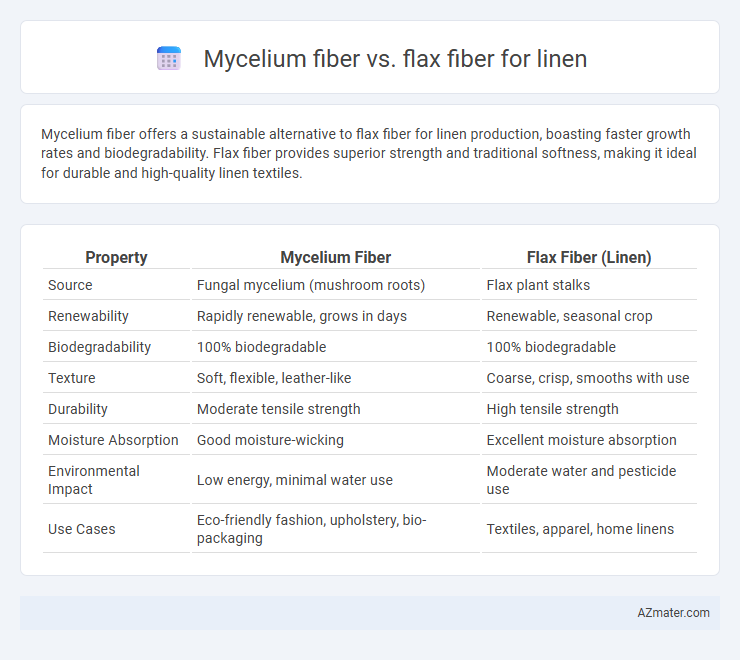Mycelium fiber offers a sustainable alternative to flax fiber for linen production, boasting faster growth rates and biodegradability. Flax fiber provides superior strength and traditional softness, making it ideal for durable and high-quality linen textiles.
Table of Comparison
| Property | Mycelium Fiber | Flax Fiber (Linen) |
|---|---|---|
| Source | Fungal mycelium (mushroom roots) | Flax plant stalks |
| Renewability | Rapidly renewable, grows in days | Renewable, seasonal crop |
| Biodegradability | 100% biodegradable | 100% biodegradable |
| Texture | Soft, flexible, leather-like | Coarse, crisp, smooths with use |
| Durability | Moderate tensile strength | High tensile strength |
| Moisture Absorption | Good moisture-wicking | Excellent moisture absorption |
| Environmental Impact | Low energy, minimal water use | Moderate water and pesticide use |
| Use Cases | Eco-friendly fashion, upholstery, bio-packaging | Textiles, apparel, home linens |
Introduction to Mycelium Fiber and Flax Fiber
Mycelium fiber, derived from the root structure of fungi, offers a sustainable and biodegradable alternative to traditional textile materials, known for its natural durability and antimicrobial properties. Flax fiber, sourced from the flax plant, is the primary raw material for linen fabric, prized for its strength, breathability, and moisture-wicking capabilities. Both fibers contribute to eco-friendly textile production but differ significantly in origin, processing methods, and functional attributes.
Origins and Sources of Mycelium and Flax Fibers
Mycelium fiber originates from the root-like structures of fungi, harvested through sustainable cultivation of mushroom mycelium on agricultural waste substrates, making it a renewable and eco-friendly material. Flax fiber is derived from the stalks of the flax plant (Linum usitatissimum), traditionally grown in temperate regions such as Europe, North America, and parts of Asia, where the fiber is extracted through retting and scutching processes. Both fibers represent natural, biodegradable sources for linen production, with mycelium offering innovative fungal origins while flax is grounded in centuries-old agricultural practices.
Production Processes: Mycelium vs Flax
Mycelium fiber production involves cultivating fungi mycelium under controlled conditions, where the network of fungal threads is grown on organic substrates and then harvested, purified, and processed into flexible, sustainable fiber sheets. Flax fiber production requires retting, drying, and scutching the flax plant stems to extract long, strong bast fibers, followed by spinning and weaving into linen fabric. Mycelium offers a faster, lower-impact growth cycle with minimal water use and no chemical retting, contrasting with flax's labor-intensive cultivation and processing reliant on water and enzymatic treatments.
Sustainability and Environmental Impact
Mycelium fiber, derived from fungal networks, offers a sustainable alternative to traditional flax fiber by utilizing low-impact, biodegradable resources that require minimal water and no pesticides, significantly reducing environmental degradation. Flax fiber production, while natural, demands substantial water and land use, along with chemical retting processes that contribute to soil and water pollution. The cultivation of mycelium fiber supports circular bioeconomy principles, promoting carbon sequestration and reducing greenhouse gas emissions compared to the more resource-intensive flax fiber processing.
Physical Properties and Performance
Mycelium fiber exhibits superior biodegradability and enhanced moisture-wicking properties compared to flax fiber, making it a sustainable alternative for linen production. Flax fiber, known for its high tensile strength and natural luster, offers exceptional durability and breathability ideal for lightweight textile applications. Performance-wise, mycelium fiber provides improved thermal insulation and flexibility, while flax fiber maintains better resistance to UV exposure and abrasion.
Applications in Textile Industry
Mycelium fiber offers sustainable and biodegradable alternatives for linen production, enhancing moisture-wicking and antimicrobial properties compared to traditional flax fiber. Flax fiber remains dominant in textile applications due to its strength, durability, and natural luster, making it ideal for high-quality linen fabrics. Innovations in blending mycelium with flax fiber are expanding applications in eco-friendly apparel, upholstery, and technical textiles.
Biodegradability and End-of-Life Scenarios
Mycelium fiber and flax fiber both offer high biodegradability, breaking down naturally without releasing harmful residues into the environment. Mycelium fiber decomposes rapidly due to its fungal origin, making it ideal for sustainable end-of-life scenarios where quick soil reintegration is desired. Flax fiber, traditionally used for linen production, biodegrades at a slower rate but provides excellent compostability and supports circular textile systems through recycling and natural decay.
Market Trends and Consumer Acceptance
Mycelium fiber and flax fiber are emerging as sustainable alternatives in the linen market, with flax fiber maintaining strong consumer trust due to its long-standing use and natural durability. Market trends indicate rising interest in mycelium fiber for its eco-friendly production process and biodegradability, appealing to environmentally conscious consumers seeking innovative materials. Flax fiber continues to dominate due to established processing infrastructure and widespread acceptance, while mycelium fiber's adoption is accelerating as advancements improve its texture and cost-efficiency.
Challenges and Limitations of Each Fiber
Mycelium fiber presents challenges such as limited large-scale production capacity and sensitivity to environmental conditions, which affect consistency and durability compared to flax fiber. Flax fiber, while more established, faces limitations like long cultivation periods, moisture sensitivity, and labor-intensive processing that impact cost and scalability. Both fibers require advancements in processing technology to improve performance and commercial viability for linen applications.
Future Prospects and Innovations
Mycelium fiber offers promising future prospects in sustainable textile development due to its rapid growth rate, biodegradability, and potential for enhanced durability compared to traditional flax fiber used in linen production. Innovations in mycelium fiber technology focus on improving texture, strength, and scalability, positioning it as a competitive alternative to flax fiber, which is renowned for its breathability and moisture-wicking properties. Continued advancements in bioengineering and material processing are expected to drive the integration of mycelium fiber into mainstream linen products, meeting increasing demand for eco-friendly textiles.

Infographic: Mycelium fiber vs Flax fiber for Linen
 azmater.com
azmater.com